
Bad Wimpfen
Encyclopedia
Bad Wimpfen is an historic spa town
in the district of Heilbronn
in the Baden-Württemberg
region of southern Germany
. It lies north of the city of Heilbronn
, on the river Neckar
.
, around 15 km to the north of Heilbronn
. The town is divided in two parts: The older Wimpfen im Tal (Lower Wimpfen/ literally Wimpfen in the valley) situated at the Neckar and Wimpfen am Berg (Upper Wimpfen/ literally Wimpfen on the hill) containing the town centre. Besides of the town itself the village Hohenstadt also belongs to Bad Wimpfen.
, Bad Rappenau
, Offenau
, Bad Friedrichshall
, Untereisesheim
and Neckarsulm
.
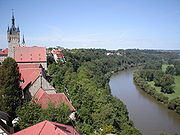

and the Bronze Age
. An old trade road running from France forks here towards Nürnberg and Öhringen
linking to the Danube
. Several archaeological finds demonstrate that the route has existed since prehistoric times.
Around 450 B.C. the Celtic tribe of the Helvetii
settled around the Neckar, Kocher and Jagst including the Bad Wimpfen site. Presumably the Celts had given names to the rivers as they are today. Wimpfen presumably comes from "uimpe" (umwallt) = "surrounded" and "bin" (Berg) = "mountain".
After the expansion of the Roman Empire
up to the Limes
near Jagsthausen arranged by emperor Antonius Pius in 138-161 A.D. the castellum lost its military importance.
All the more important was Wimpfen im Tal as a civil town. It has been the centre of a district called Civitas Alisinensium and was surrounded by a city wall like just a few Roman towns in today's southern Germany. The surface has been about 19 hectare being one of the biggest Roman towns in today's Baden-Württemberg. Despite this importance the Latin name of the town is unknown today.
Besides there has been a wooden bridge above the Neckar getting destroyed by severe ice occurrence in early Middle Ages. The origin of a beam salvaged during excavator works in 1957 is proved to be a part of the old bridge. A survey proved a year around 85 A.D.
governed the Neckar area since 260 A.D. During this time the most Roman buildings dilapidated, since the Alamanni didn't know anything about stone building and how to use Roman infrastructure. Around 500 Wimpfen came to Franconia
. By the settlement of the Franks
according to Clovis I
Christianity has been bloomed, so the today's oldest Christian buildings originate from this time.
In the 9th century Wimpfen came to the Bishopric of Worms and was first mentioned documentary as Wimpina in 829. In this time the Hungarians attacked the region and devastated the most settlements including Wimpfen. Within the framework of the following reconstruction the new diocese church St. Peter was built. Being a bigger building, it was dedicated to the patron of the Bishopric of Worms. During more than three centuries the local dioceses had been performed the jurisdiction there.
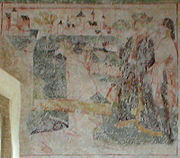
 In 965 a document dictated by King Otto I
In 965 a document dictated by King Otto I
granted market rights to Wimpfen. Due to the good location in terms of transport, and catchment area, the market developed significantly. Wimpfen's Talmarkt (valley market) has a history of more than 1000 years and is one of the longest running traditional market events in Germany.
In 1182 Friedrich Barbarossa
is believed to have lodged in Wimpfen. He had decentralised the administration of his empire. The Staufers had built Kaiserpfalzen (local castles) across the empire. These were big castles where local lords stayed and jurisdicted. The Pfalz Wimpfen was built on a rocky hill above the settlement of the Neckar valley. The Pfalz and its surrounding settlement grew so strong that it outstripped the older settlement on the Neckar bank. By around 1200 most of the Staufer buildings had been built, including the Blauer Turm (Blue Tower) which is now generally seen as the principal visual landmark of the town. It served as a watch-tower until the 20th century.
The Stauferpfalz of Wimpfen is the biggest preserved one north of the Alps. Its original length was about 215m, its width about 88m. Emperor Henry VI
has been stayed there at least three times, Friedrich II.
eight times. In 1235 there was a historical meeting between Friedrich II and his rebellious son. Also in the 13th century Richard von Deidesheim arranged a rebuilding of the diocese church into the Gothic style. At the same time a hospital and a Dominican's monastery was founded.
Due to the decline of the Staufers Empire, Wimpfen became a Reichsstadt, so many manual workers settled down and the population grew, establishing a large core of citizens. A town constitution was established, setting an example to many other towns.
Many of today's buildings originate from this time.
Emperor Friedrich III.
gave the right to hold a second annual market, over and above the established Talmarkt, which was called the Katharinenmarkt. This second market before christmas also survives in todays christmas market, and its fame extends over to the whole Baden-Württemberg region.
who preached here from 1523 to 1526. His contemporary Heinrich Vogtherr
wrote many reforming essays and hymns. Although the Catholics offered huge resistance to the Reformation, their influence and number decreased. By 1588 there were only 30 Catholic inhabitants. Catholics eventually lost their civil rights and their churches were converted to Protestant use.
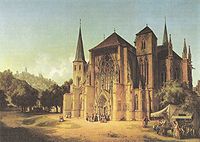 This religious conflict soon got less important, since troops of imperial Johann Tserclaes fought against the army of Margrave Georg Friedrich
This religious conflict soon got less important, since troops of imperial Johann Tserclaes fought against the army of Margrave Georg Friedrich
in 1622 nearby the town. This "Battle of Wimpfen
" was one of the most important and bloody ones during Thirty Years' War
.
During this period Wimpfen was looted several times, and houses and fields were burned. The population decreased radically due to disease and epidemics. At the end of the war, in 1648, the population had been reduced to a tenth of its pre-war size. Many important buildings were destroyed in this period, and redevelopment brought about loss of large parts of the castle which was used for building materials.
The town suffered the devastating consequences of the Thirty Years' War for more than 150 years. Although the Celts had extracted salt since pre-Christian times, there was now no possibility to produce salt. There was huge poverty within the population. During this time the town got financial aid from Nürnberg.
In 1783 it was declared that the removal of wood from surrounding forests was to be taxed to improve the town's financial situation. However, the citizens could not afford these fees. Consequently there were many riots, but ultimately these were suppressed by local orders.
Originally, in terms of administration, by the Reichsdeputationshauptschluss the town came to Baden. However, the knightly diocese of Wimpfen im Tal came to Hesse-Darmstadt
. Consequently, a conflict about sovereignty rights over the diocese increased between Baden and Hesse. Finally Baden agreed to concede the area, since their own territory was far away - and so Wimpfen came to Hesse. This change was officially proclaimed on April 5, 1803. Since 1805/06 Wimpfen was an outlying town under the control of Hesse.
This was a very comfortable situation to Wimpfen, being able to administer itself autonomously. At the time of the foundation of the People's State of Hesse in 1919, Wimpfen became part of the district of Heppenheim
. It was fused with the district of Bensheim
in 1938, and given the status of Kreis Bergstraße
. In total, Wimpfen belonged to Hesse for 140 years. In 1945 the American military government
reorganised administrational areas, and Bad Wimpfen came under the control of Baden.
In 1817 a permanent salt production works was established. The brine was usually able to be used therapeutically, and in 1835 the first therapeutic hotel opened (Mathilden Spa Hotel). A new economic prosperity began, and a new town hall was built in 1836. Many of the older Staufer buildings were destroyed at this time or fell into disrepair or disuse.
After the opening of the new rail road, running from Heilbronn to Heidelberg, in the 1860s, the spa business increased greatly. Therapeutic baths were expanded more and more, resulting in a major economic growth. Even Mark Twain
reported this fact within accounts of his journey through Europe in 1867. On April 26, 1930, the town got its prefix Bad officially.
The town survived World War II almost undamaged, and many refugees came here for accommodation.
and Württemberg-Baden
. Now the area was completely surrounded by Württemberg-Baden, namely by the districts of Sinsheim and Heilbronn belonging to Baden area of Württemberg. On November 26 the occupying American officials decided to transfer control of Wimpfen to the district of Sinsheim. Eventually the town became a part of Württemberg-Baden legally, this being confirmed by the OLG in Stuttgart on March 6, 1951.
Within the population this decision was not well accepted. Even Hesse demanded a return of its enclave. In a plebiscite vote of April 29, 1951, only 0.7% of the inhabitants voted to stay in the district of Sinsheim. Around 41% voted to return to Hesse, but a mayority of 57% decided to change into the district of Heilbronn. This change to Heilbronn was been carried out on May 1, 1952.
Despite this result, Hesse continued in its opinion that Bad Wimpfen was a Hessian town. However, it agreed that the newly founded district of Baden-Württemberg should administer the town. This means that the final status of any affiliation remains unclear even today. However, Bad Wimpfen is completely integrated into the administration and jurisdiction of Baden-Württemberg.
Due to its Hessian past, the Catholic Church still belongs as an exclave to the Diocese of Mainz.
and some Jehovah's Witnesses
. From 1947 to 2006 the buildings adjacent to the catholic church St. Peter housed Grüssau Abbey
. This Benedictine
monastery, in the district of Heilbronn, containing only three monks in 2005, was eventually closed in the autumn of 2006. Now the remaining monks live in Neuburg Abbey
near Heidelberg, Sigmaringen
, Kellenried Abbey
and Pannonhalma Archabbey
.
Formerly there also was a Jewish representation in the town. An early-mentioned Jew who lived in Wimpfen was Alexander ben Salomo, who released the remains of Rabbi Meir of Rothenburg
in the early 14th century. Both are buried in Worms
. Jews are known to have lived in Wimpfen in the 14th, 15th and 16th century. Around 1550 there was a brief expulsion of Jews. From the 17th century Jewish families lived in at least five houses in Bad Wimpfen, although several orders were passed that discriminated against them—1598, 1630, 1756 and 1762. In 1672 there was an expulsion, cancelled two years later. Jews were given some equality in the years of imperial township, but by 1933 only 22 Jews lived in Bad Wimpfen and they faced increasing discrimination by the Nazi party. The 1938 riots against Jews forced them to leave their homes and businesses. At least four deaths are known to have occurred during this persecution.
The mayor is also a member of the district council and its chairman.
 Blazon
Blazon
: In gold the red Eagle of Empire with a horizontal silver key in its beak. The town colours are red, white and blue.
The coat of arms of Eagle
and key already appear in Wimpfen's seal of 1250, used until 1436. The eagle was a former symbol of Wimpfen's dependency on the empire in the time of Staufer. Since the 14th century it was the symbol of the free imperial city. The key is both the emblem of Saint Peter
and the coat of arms of the Bishopric of Worms
. It indicates that the castle was built on communal land of Worms. Over the course of time the key position changed several times.
During the time of the town's Hessian membership a different coat of arms was utilised. However, this was abandoned at the time of the change of administration to Baden.
with:
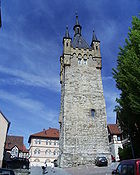
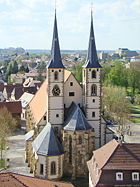
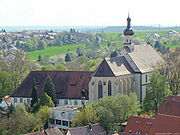 The Protestant Stadtkirche was built in the 13th century in Romanesque architecture
The Protestant Stadtkirche was built in the 13th century in Romanesque architecture
and ended in Gothic architecture
. Next to the church there's the calvary.
The construction of the Dominikanerkirche presumably started in the 13th and ended in the 18th century. The former monastery with artistic cloister contents a school today. The church is used as the Catholic parish church.
The former Johanneskirche was built in the 15th century and rebuilt in 1778. It got secularizated
in 1803. By a fire in 1851 the church lost its function, since then the building served as a restaurant.
In the castle quarter on Schwibbogengasse lies the former Jewish synagogue of 1580. This was seized in the 1930s and converted to flats.
The diocese church St. Peter in Wimpfen im Tal, under the control of Grüssau Abbey
from 1947 to 2004, presumably goes back to the 7th century. Today's church with its bordering cloister was built in the 13th and 14th century. There was a comprehensive renovation in 2006.
The Cornelienkirche lies east of the centre of Wimpfen im Tal. The building was built in 1476 in the Gothic style has a splendid portal with wall murals. It is believed that Tilly camped here during the Battle of Wimpfen.
Nearby, the village of Hohenstadt
contains an old Protestant parish church.
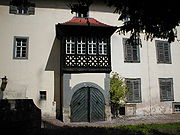
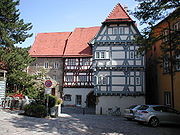 There are several museums inside the historical old part of the town.
There are several museums inside the historical old part of the town.
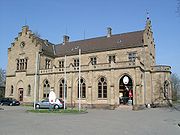 One of the biggest employers in Bad Wimpfen is Solvay Fluor GmbH containing more than 350 employees and producing different products in Fluorine
One of the biggest employers in Bad Wimpfen is Solvay Fluor GmbH containing more than 350 employees and producing different products in Fluorine
chemistry, e. g. refrigerant
s and propellant
s. Also many inhabitants are working at the AUDI AG
in Neckarsulm
.
to Heidelberg
. The station, dating from 1868 is a rare Neo-Gothic style, which many consider to appear Scottish in influence. It contains the local Tourist Information Office.
The town lies near the A 6
(junction Heilbronn/Untereisesheim).
In addition, there is the Hohenstaufen-Gymnasium which has more than 900 students from Bad Wimpfen and its surrounding municipalities.
Spa town
A spa town is a town situated around a mineral spa . Patrons resorted to spas to "take the waters" for their purported health benefits. The word comes from the Belgian town Spa. In continental Europe a spa was known as a ville d'eau...
in the district of Heilbronn
Heilbronn (district)
Heilbronn is a district in the north of Baden-Württemberg, Germany. Neighboring districts are Neckar-Odenwald, Hohenlohe, Schwäbisch Hall, Rems-Murr, Ludwigsburg, Enz, Karlsruhe and Rhein-Neckar...
in the Baden-Württemberg
Baden-Württemberg
Baden-Württemberg is one of the 16 states of Germany. Baden-Württemberg is in the southwestern part of the country to the east of the Upper Rhine, and is the third largest in both area and population of Germany's sixteen states, with an area of and 10.7 million inhabitants...
region of southern Germany
Germany
Germany , officially the Federal Republic of Germany , is a federal parliamentary republic in Europe. The country consists of 16 states while the capital and largest city is Berlin. Germany covers an area of 357,021 km2 and has a largely temperate seasonal climate...
. It lies north of the city of Heilbronn
Heilbronn
Heilbronn is a city in northern Baden-Württemberg, Germany. It is completely surrounded by Heilbronn County and with approximately 123.000 residents, it is the sixth-largest city in the state....
, on the river Neckar
Neckar
The Neckar is a long river, mainly flowing through the southwestern state of Baden-Württemberg, but also a short section through Hesse, in Germany. The Neckar is a major right tributary of the River Rhine...
.
Geography
Bad Wimpfen is situated on the west bank of the River NeckarNeckar
The Neckar is a long river, mainly flowing through the southwestern state of Baden-Württemberg, but also a short section through Hesse, in Germany. The Neckar is a major right tributary of the River Rhine...
, around 15 km to the north of Heilbronn
Heilbronn
Heilbronn is a city in northern Baden-Württemberg, Germany. It is completely surrounded by Heilbronn County and with approximately 123.000 residents, it is the sixth-largest city in the state....
. The town is divided in two parts: The older Wimpfen im Tal (Lower Wimpfen/ literally Wimpfen in the valley) situated at the Neckar and Wimpfen am Berg (Upper Wimpfen/ literally Wimpfen on the hill) containing the town centre. Besides of the town itself the village Hohenstadt also belongs to Bad Wimpfen.
Neighbouring municipalities
Neighbouring town and municipalities of Bad Wimpfen are (clockwise from the south): HeilbronnHeilbronn
Heilbronn is a city in northern Baden-Württemberg, Germany. It is completely surrounded by Heilbronn County and with approximately 123.000 residents, it is the sixth-largest city in the state....
, Bad Rappenau
Bad Rappenau
Bad Rappenau is a town in the district of Heilbronn in Baden-Württemberg in southern Germany. It is situated about 15 km northwest of Heilbronn.- Neighbouring municipalities :...
, Offenau
Offenau
Offenau is a town in the district of Heilbronn in Baden-Württemberg in Germany....
, Bad Friedrichshall
Bad Friedrichshall
Bad Friedrichshall is a town in the district of Heilbronn in Baden-Württemberg in southern Germany. It is situated at the confluence of the Jagst and the Kocher into the Neckar, 10 km north of Heilbronn...
, Untereisesheim
Untereisesheim
Untereisesheim is a town in the district of Heilbronn in Baden-Württemberg in Germany....
and Neckarsulm
Neckarsulm
Neckarsulm is a city in northern Baden-Württemberg, Germany, near Stuttgart, and part of the district Heilbronn. As of 2004, Neckarsulm had 27,296 inhabitants....
.
History


First settlement by the Celts
First traces of settlement at Bad Wimpfen date from the NeolithicNeolithic
The Neolithic Age, Era, or Period, or New Stone Age, was a period in the development of human technology, beginning about 9500 BC in some parts of the Middle East, and later in other parts of the world. It is traditionally considered as the last part of the Stone Age...
and the Bronze Age
Bronze Age
The Bronze Age is a period characterized by the use of copper and its alloy bronze as the chief hard materials in the manufacture of some implements and weapons. Chronologically, it stands between the Stone Age and Iron Age...
. An old trade road running from France forks here towards Nürnberg and Öhringen
Öhringen
Öhringen is the largest city in Hohenlohe in the state of Baden-Württemberg, in southwest Germany, near Heilbronn. Öhringen is on the railways to Schwäbisch Hall and Crailsheim.With a population of 22,745 , the city is diverse...
linking to the Danube
Danube
The Danube is a river in the Central Europe and the Europe's second longest river after the Volga. It is classified as an international waterway....
. Several archaeological finds demonstrate that the route has existed since prehistoric times.
Around 450 B.C. the Celtic tribe of the Helvetii
Helvetii
The Helvetii were a Celtic tribe or tribal confederation occupying most of the Swiss plateau at the time of their contact with the Roman Republic in the 1st century BC...
settled around the Neckar, Kocher and Jagst including the Bad Wimpfen site. Presumably the Celts had given names to the rivers as they are today. Wimpfen presumably comes from "uimpe" (umwallt) = "surrounded" and "bin" (Berg) = "mountain".
Roman time
It is believed that around 98 A.D. the Romans secured the area in south-western Germany conquered by Domitian (called the Dekumatland) by the Neckar-Odenwald-Limes, a system of castella built every 12-15 kilometres. In opposite to the Jagst mouth the castellum Wimpfen im Tal has been created. Like other places, a civil settlement formed around the castellum containing many traders and manual workers.After the expansion of the Roman Empire
Roman Empire
The Roman Empire was the post-Republican period of the ancient Roman civilization, characterised by an autocratic form of government and large territorial holdings in Europe and around the Mediterranean....
up to the Limes
Limes
A limes was a border defense or delimiting system of Ancient Rome. It marked the boundaries of the Roman Empire.The Latin noun limes had a number of different meanings: a path or balk delimiting fields, a boundary line or marker, any road or path, any channel, such as a stream channel, or any...
near Jagsthausen arranged by emperor Antonius Pius in 138-161 A.D. the castellum lost its military importance.
All the more important was Wimpfen im Tal as a civil town. It has been the centre of a district called Civitas Alisinensium and was surrounded by a city wall like just a few Roman towns in today's southern Germany. The surface has been about 19 hectare being one of the biggest Roman towns in today's Baden-Württemberg. Despite this importance the Latin name of the town is unknown today.
Besides there has been a wooden bridge above the Neckar getting destroyed by severe ice occurrence in early Middle Ages. The origin of a beam salvaged during excavator works in 1957 is proved to be a part of the old bridge. A survey proved a year around 85 A.D.
Development until Middle Ages
After the withdrawal of the Romans the AlamanniAlamanni
The Alamanni, Allemanni, or Alemanni were originally an alliance of Germanic tribes located around the upper Rhine river . One of the earliest references to them is the cognomen Alamannicus assumed by Roman Emperor Caracalla, who ruled the Roman Empire from 211 to 217 and claimed thereby to be...
governed the Neckar area since 260 A.D. During this time the most Roman buildings dilapidated, since the Alamanni didn't know anything about stone building and how to use Roman infrastructure. Around 500 Wimpfen came to Franconia
Franconia
Franconia is a region of Germany comprising the northern parts of the modern state of Bavaria, a small part of southern Thuringia, and a region in northeastern Baden-Württemberg called Tauberfranken...
. By the settlement of the Franks
Franks
The Franks were a confederation of Germanic tribes first attested in the third century AD as living north and east of the Lower Rhine River. From the third to fifth centuries some Franks raided Roman territory while other Franks joined the Roman troops in Gaul. Only the Salian Franks formed a...
according to Clovis I
Clovis I
Clovis Leuthwig was the first King of the Franks to unite all the Frankish tribes under one ruler, changing the leadership from a group of royal chieftains, to rule by kings, ensuring that the kingship was held by his heirs. He was also the first Catholic King to rule over Gaul . He was the son...
Christianity has been bloomed, so the today's oldest Christian buildings originate from this time.
In the 9th century Wimpfen came to the Bishopric of Worms and was first mentioned documentary as Wimpina in 829. In this time the Hungarians attacked the region and devastated the most settlements including Wimpfen. Within the framework of the following reconstruction the new diocese church St. Peter was built. Being a bigger building, it was dedicated to the patron of the Bishopric of Worms. During more than three centuries the local dioceses had been performed the jurisdiction there.
Growth of Trade


Otto I, Holy Roman Emperor
Otto I the Great , son of Henry I the Fowler and Matilda of Ringelheim, was Duke of Saxony, King of Germany, King of Italy, and "the first of the Germans to be called the emperor of Italy" according to Arnulf of Milan...
granted market rights to Wimpfen. Due to the good location in terms of transport, and catchment area, the market developed significantly. Wimpfen's Talmarkt (valley market) has a history of more than 1000 years and is one of the longest running traditional market events in Germany.
In 1182 Friedrich Barbarossa
Frederick I, Holy Roman Emperor
Frederick I Barbarossa was a German Holy Roman Emperor. He was elected King of Germany at Frankfurt on 4 March 1152 and crowned in Aachen on 9 March, crowned King of Italy in Pavia in 1155, and finally crowned Roman Emperor by Pope Adrian IV, on 18 June 1155, and two years later in 1157 the term...
is believed to have lodged in Wimpfen. He had decentralised the administration of his empire. The Staufers had built Kaiserpfalzen (local castles) across the empire. These were big castles where local lords stayed and jurisdicted. The Pfalz Wimpfen was built on a rocky hill above the settlement of the Neckar valley. The Pfalz and its surrounding settlement grew so strong that it outstripped the older settlement on the Neckar bank. By around 1200 most of the Staufer buildings had been built, including the Blauer Turm (Blue Tower) which is now generally seen as the principal visual landmark of the town. It served as a watch-tower until the 20th century.
The Stauferpfalz of Wimpfen is the biggest preserved one north of the Alps. Its original length was about 215m, its width about 88m. Emperor Henry VI
Henry VI, Holy Roman Emperor
Henry VI was King of Germany from 1190 to 1197, Holy Roman Emperor from 1191 to 1197 and King of Sicily from 1194 to 1197.-Early years:Born in Nijmegen,...
has been stayed there at least three times, Friedrich II.
Frederick II, Holy Roman Emperor
Frederick II , was one of the most powerful Holy Roman Emperors of the Middle Ages and head of the House of Hohenstaufen. His political and cultural ambitions, based in Sicily and stretching through Italy to Germany, and even to Jerusalem, were enormous...
eight times. In 1235 there was a historical meeting between Friedrich II and his rebellious son. Also in the 13th century Richard von Deidesheim arranged a rebuilding of the diocese church into the Gothic style. At the same time a hospital and a Dominican's monastery was founded.
Due to the decline of the Staufers Empire, Wimpfen became a Reichsstadt, so many manual workers settled down and the population grew, establishing a large core of citizens. A town constitution was established, setting an example to many other towns.
Many of today's buildings originate from this time.
Emperor Friedrich III.
Frederick III, Holy Roman Emperor
Frederick the Peaceful KG was Duke of Austria as Frederick V from 1424, the successor of Albert II as German King as Frederick IV from 1440, and Holy Roman Emperor as Frederick III from 1452...
gave the right to hold a second annual market, over and above the established Talmarkt, which was called the Katharinenmarkt. This second market before christmas also survives in todays christmas market, and its fame extends over to the whole Baden-Württemberg region.
Times of Reformation
In the 16th century Wimpfen was a focal point of the Reformation. Probably the most important reformer was Erhard SchnepfErhard Schnepf
Erhard Schnepf was a German Lutheran Theologian, Pastor, and Reformer.- Life :...
who preached here from 1523 to 1526. His contemporary Heinrich Vogtherr
Heinrich Vogtherr
Heinrich Vogtherr was an artist, printer, poet and medical author of the Reformation period.-References:...
wrote many reforming essays and hymns. Although the Catholics offered huge resistance to the Reformation, their influence and number decreased. By 1588 there were only 30 Catholic inhabitants. Catholics eventually lost their civil rights and their churches were converted to Protestant use.
Thirty Years' War

Georg Friedrich, Margrave of Baden-Durlach
George Frederick of Baden-Durlach was Margrave of Baden-Durlach from 1604 until his abdication in 1622. He also ruled Baden-Baden....
in 1622 nearby the town. This "Battle of Wimpfen
Battle of Wimpfen
The Battle of Wimpfen was a battle in the Bohemian Revolt period of the Thirty Years' War on 6 May 1622 near Wimpfen. The forces of the Holy Roman Empire and Catholic League under Marshal Tilly and Gonzalo de Córdoba defeated the Protestant forces of General Ernst von Mansfeld and Georg Friedrich,...
" was one of the most important and bloody ones during Thirty Years' War
Thirty Years' War
The Thirty Years' War was fought primarily in what is now Germany, and at various points involved most countries in Europe. It was one of the most destructive conflicts in European history....
.
During this period Wimpfen was looted several times, and houses and fields were burned. The population decreased radically due to disease and epidemics. At the end of the war, in 1648, the population had been reduced to a tenth of its pre-war size. Many important buildings were destroyed in this period, and redevelopment brought about loss of large parts of the castle which was used for building materials.
The town suffered the devastating consequences of the Thirty Years' War for more than 150 years. Although the Celts had extracted salt since pre-Christian times, there was now no possibility to produce salt. There was huge poverty within the population. During this time the town got financial aid from Nürnberg.
In 1783 it was declared that the removal of wood from surrounding forests was to be taxed to improve the town's financial situation. However, the citizens could not afford these fees. Consequently there were many riots, but ultimately these were suppressed by local orders.
Originally, in terms of administration, by the Reichsdeputationshauptschluss the town came to Baden. However, the knightly diocese of Wimpfen im Tal came to Hesse-Darmstadt
Grand Duchy of Hesse
The Grand Duchy of Hesse and by Rhine , or, between 1806 and 1816, Grand Duchy of Hesse —as it was also known after 1816—was a member state of the German Confederation from 1806, when the Landgraviate of Hesse-Darmstadt was elevated to a Grand Duchy, until 1918, when all the German...
. Consequently, a conflict about sovereignty rights over the diocese increased between Baden and Hesse. Finally Baden agreed to concede the area, since their own territory was far away - and so Wimpfen came to Hesse. This change was officially proclaimed on April 5, 1803. Since 1805/06 Wimpfen was an outlying town under the control of Hesse.
This was a very comfortable situation to Wimpfen, being able to administer itself autonomously. At the time of the foundation of the People's State of Hesse in 1919, Wimpfen became part of the district of Heppenheim
Heppenheim
Heppenheim is the seat of Bergstraße district in Hesse, Germany, lying on the Bergstraße on the edge of the Odenwald.- Location :...
. It was fused with the district of Bensheim
Bensheim
Bensheim is a town in the Bergstraße district in southern Hesse, Germany. Bensheim lies on the Bergstraße and at the edge of the Odenwald mountains while at the same time having an open view over the Rhine plain...
in 1938, and given the status of Kreis Bergstraße
Kreis Bergstraße
Bergstraße is a Kreis in the south of Hesse, Germany. Neighboring districts are Groß-Gerau, Darmstadt-Dieburg, Odenwaldkreis, Rhein-Neckar-Kreis, the urban district Mannheim, the Rhein-Pfalz-Kreis, and the urban district of Worms...
. In total, Wimpfen belonged to Hesse for 140 years. In 1945 the American military government
Office of Military Government, United States
The Office of Military Government, United States was the United States military-established government created shortly after the end of hostilities in occupied Germany in World War II. Under General Lucius D...
reorganised administrational areas, and Bad Wimpfen came under the control of Baden.
Salt production and bathing
In 1752 the first bore-holes were drilled for salt-water.In 1817 a permanent salt production works was established. The brine was usually able to be used therapeutically, and in 1835 the first therapeutic hotel opened (Mathilden Spa Hotel). A new economic prosperity began, and a new town hall was built in 1836. Many of the older Staufer buildings were destroyed at this time or fell into disrepair or disuse.
After the opening of the new rail road, running from Heilbronn to Heidelberg, in the 1860s, the spa business increased greatly. Therapeutic baths were expanded more and more, resulting in a major economic growth. Even Mark Twain
Mark Twain
Samuel Langhorne Clemens , better known by his pen name Mark Twain, was an American author and humorist...
reported this fact within accounts of his journey through Europe in 1867. On April 26, 1930, the town got its prefix Bad officially.
The town survived World War II almost undamaged, and many refugees came here for accommodation.
Between Hesse and Baden-Württemberg
On September 19, 1945, the American military government proclaimed the foundation of Greater HesseGreater Hesse
Greater Hesse was the provisional name given for a section of German territory created by the US military administration in at the end of World War II...
and Württemberg-Baden
Württemberg-Baden
Württemberg-Baden is a former state of Federal Republic of Germany. It was created in 1945 by the U.S. occupation forces, after the previous states of Baden and Württemberg had been split up between the US and French occupation zones. Its capital was Stuttgart...
. Now the area was completely surrounded by Württemberg-Baden, namely by the districts of Sinsheim and Heilbronn belonging to Baden area of Württemberg. On November 26 the occupying American officials decided to transfer control of Wimpfen to the district of Sinsheim. Eventually the town became a part of Württemberg-Baden legally, this being confirmed by the OLG in Stuttgart on March 6, 1951.
Within the population this decision was not well accepted. Even Hesse demanded a return of its enclave. In a plebiscite vote of April 29, 1951, only 0.7% of the inhabitants voted to stay in the district of Sinsheim. Around 41% voted to return to Hesse, but a mayority of 57% decided to change into the district of Heilbronn. This change to Heilbronn was been carried out on May 1, 1952.
Despite this result, Hesse continued in its opinion that Bad Wimpfen was a Hessian town. However, it agreed that the newly founded district of Baden-Württemberg should administer the town. This means that the final status of any affiliation remains unclear even today. However, Bad Wimpfen is completely integrated into the administration and jurisdiction of Baden-Württemberg.
Due to its Hessian past, the Catholic Church still belongs as an exclave to the Diocese of Mainz.
Present
In present-day Bad Wimpfen the town is impressive both due to its various spa institutions and due to its numerous fine historic buildings. The historical old part of the town is protected completely. Since 1976 a comprehensive program of redevelopment resulted in an important restoration of most buildings. Due to the recession of the 1990s, private initiatives have now superseded the earlier state interventions, but generally development speed has decreased and settled.Religions
Except for a Protestant and Catholic parish in Bad Wimpfen, the town also has a New Apostolic ChurchNew Apostolic Church
The New Apostolic Church is a chiliastic church, converted to Protestantism as a free church from the Catholic Apostolic Church. The church has existed since 1879 in Germany and since 1897 in the Netherlands...
and some Jehovah's Witnesses
Jehovah's Witnesses
Jehovah's Witnesses is a millenarian restorationist Christian denomination with nontrinitarian beliefs distinct from mainstream Christianity. The religion reports worldwide membership of over 7 million adherents involved in evangelism, convention attendance of over 12 million, and annual...
. From 1947 to 2006 the buildings adjacent to the catholic church St. Peter housed Grüssau Abbey
Grüssau Abbey
Grüssau Abbey also known as Krzeszów Abbey refers to a historical Cistercian monastery in Krzeszów in Lower Silesia, and to a house of the Benedictine Order in the town of Bad Wimpfen in Baden-Württemberg, where the German Grüssau community moved in 1947, after their former abbey had become...
. This Benedictine
Order of Saint Benedict
The Order of Saint Benedict is a Roman Catholic religious order of independent monastic communities that observe the Rule of St. Benedict. Within the order, each individual community maintains its own autonomy, while the organization as a whole exists to represent their mutual interests...
monastery, in the district of Heilbronn, containing only three monks in 2005, was eventually closed in the autumn of 2006. Now the remaining monks live in Neuburg Abbey
Neuburg Abbey
Neuburg Abbey near Heidelberg in Baden-Württemberg is a Benedictine monastery dedicated to Saint Bartholomew, and part of the Beuronese Congregation.-First foundation:...
near Heidelberg, Sigmaringen
Sigmaringen
Sigmaringen is a town in southern Germany, in the state of Baden-Württemberg. Situated on the upper Danube, it is the capital of the Sigmaringen district....
, Kellenried Abbey
Kellenried Abbey
St. Erentraud's Abbey, Kellenried, otherwise Kellenried Abbey, is a Benedictine nunnery in Kellenried, which is part of Berg near Ravensburg, Baden-Württemberg, Germany....
and Pannonhalma Archabbey
Pannonhalma Archabbey
The Benedictine Pannonhalma Archabbey is the most notable landmark in Pannonhalma and one of the oldest historical monuments in Hungary, founded in the year 996. It is located near the town, on top of a hill...
.
Formerly there also was a Jewish representation in the town. An early-mentioned Jew who lived in Wimpfen was Alexander ben Salomo, who released the remains of Rabbi Meir of Rothenburg
Meir of Rothenburg
Meir of Rothenburg was a German Rabbi and poet, a major author of the tosafot on Rashi's commentary on the Talmud...
in the early 14th century. Both are buried in Worms
Worms, Germany
Worms is a city in Rhineland-Palatinate, Germany, on the Rhine River. At the end of 2004, it had 85,829 inhabitants.Established by the Celts, who called it Borbetomagus, Worms today remains embattled with the cities Trier and Cologne over the title of "Oldest City in Germany." Worms is the only...
. Jews are known to have lived in Wimpfen in the 14th, 15th and 16th century. Around 1550 there was a brief expulsion of Jews. From the 17th century Jewish families lived in at least five houses in Bad Wimpfen, although several orders were passed that discriminated against them—1598, 1630, 1756 and 1762. In 1672 there was an expulsion, cancelled two years later. Jews were given some equality in the years of imperial township, but by 1933 only 22 Jews lived in Bad Wimpfen and they faced increasing discrimination by the Nazi party. The 1938 riots against Jews forced them to leave their homes and businesses. At least four deaths are known to have occurred during this persecution.
District council
Following the municipal election of 13 June 2004, the district council of Bad Wimpfen has 17 seats. The election result is as follows:| party | amount | seats | ||
| CDU Christian Democratic Union (Germany) The Christian Democratic Union of Germany is a Christian democratic and conservative political party in Germany. It is regarded as on the centre-right of the German political spectrum... / FW |
49.6% | (+4.8) | 9 | (+1) |
| SPD Social Democratic Party of Germany The Social Democratic Party of Germany is a social-democratic political party in Germany... |
24.8% | (−0.8) | 3 | (−1) |
| FDP Free Democratic Party (Germany) The Free Democratic Party , abbreviated to FDP, is a centre-right classical liberal political party in Germany. It is led by Philipp Rösler and currently serves as the junior coalition partner to the Union in the German federal government... / DVP Democratic People's Party (Germany) Democratic People's Party was the name of two liberal parties in southern Germany. It is not to be confused with the Deutsche Volkspartei of 1918 which used the same abbreviation DVP.... / Unabhängige Bürger (UB) |
16.6% | (+2.0) | 3 | (+1) |
| GRÜNE Alliance '90/The Greens Alliance '90/The Greens is a green political party in Germany, formed from the merger of the German Green Party and Alliance 90 in 1993. Its leaders are Claudia Roth and Cem Özdemir... / Offene Liste (GOL) |
11.4% | (+4.4) | 2 | (+1) |
| Others | 0.0% | (−10.4) | 0 | (−2) |
The mayor is also a member of the district council and its chairman.
Arms and flag

Blazon
In heraldry and heraldic vexillology, a blazon is a formal description of a coat of arms, flag or similar emblem, from which the reader can reconstruct the appropriate image...
: In gold the red Eagle of Empire with a horizontal silver key in its beak. The town colours are red, white and blue.
The coat of arms of Eagle
Eagle (heraldry)
The eagle is used in heraldry as a charge, as a supporter, and as a crest. Parts of the eagle's body such as its head, wings or leg are also used as a charge or crest....
and key already appear in Wimpfen's seal of 1250, used until 1436. The eagle was a former symbol of Wimpfen's dependency on the empire in the time of Staufer. Since the 14th century it was the symbol of the free imperial city. The key is both the emblem of Saint Peter
Saint Peter
Saint Peter or Simon Peter was an early Christian leader, who is featured prominently in the New Testament Gospels and the Acts of the Apostles. The son of John or of Jonah and from the village of Bethsaida in the province of Galilee, his brother Andrew was also an apostle...
and the coat of arms of the Bishopric of Worms
Bishopric of Worms
The Bishopric of Worms was an ecclesiastical principality of the Holy Roman Empire. Located on both banks of the Rhine around Worms just north of the union of that river with the Neckar, it was largely surrounded by the Palatinate. Worms had been the seat of a bishop from Roman times...
. It indicates that the castle was built on communal land of Worms. Over the course of time the key position changed several times.
During the time of the town's Hessian membership a different coat of arms was utilised. However, this was abandoned at the time of the change of administration to Baden.
International relations
Bad Wimpfen is twinnedTown twinning
Twin towns and sister cities are two of many terms used to describe the cooperative agreements between towns, cities, and even counties in geographically and politically distinct areas to promote cultural and commercial ties.- Terminology :...
with:
- Servian in the FrenchFranceThe French Republic , The French Republic , The French Republic , (commonly known as France , is a unitary semi-presidential republic in Western Europe with several overseas territories and islands located on other continents and in the Indian, Pacific, and Atlantic oceans. Metropolitan France...
DépartementDépartements of FranceThe departments of France are French administrative divisions. The 101 departments form one of the three levels of local government, together with the 22 metropolitan and 5 overseas regions above them and more than 36 000 communes beneath them...
HéraultHéraultHérault is a department in the south of France named after the Hérault river.-History:Hérault is one of the original 83 departments created during the French Revolution on 4 March 1790...
, since 1967.
- Ödenburg (today's Sopron) in HungaryHungaryHungary , officially the Republic of Hungary , is a landlocked country in Central Europe. It is situated in the Carpathian Basin and is bordered by Slovakia to the north, Ukraine and Romania to the east, Serbia and Croatia to the south, Slovenia to the southwest and Austria to the west. The...
since 1951, offering the town refuge to their many exiles after World War II.
Culture and sights


Kaiserpfalz
The most important building in Bad Wimpfen is the Kaiserpfalz. Its most potent remaining symbol is the Blauer Turm (Blue Tower), which was occupied for 650 years. The tower is open to visitors and offers a spectacular panorama over the whole town. The Roter Turm (Red Tower) dating from c.1200 is a second tower of the Pfalz.Historic Churches

Romanesque architecture
Romanesque architecture is an architectural style of Medieval Europe characterised by semi-circular arches. There is no consensus for the beginning date of the Romanesque architecture, with proposals ranging from the 6th to the 10th century. It developed in the 12th century into the Gothic style,...
and ended in Gothic architecture
Gothic architecture
Gothic architecture is a style of architecture that flourished during the high and late medieval period. It evolved from Romanesque architecture and was succeeded by Renaissance architecture....
. Next to the church there's the calvary.
The construction of the Dominikanerkirche presumably started in the 13th and ended in the 18th century. The former monastery with artistic cloister contents a school today. The church is used as the Catholic parish church.
The former Johanneskirche was built in the 15th century and rebuilt in 1778. It got secularizated
Secularization
Secularization is the transformation of a society from close identification with religious values and institutions toward non-religious values and secular institutions...
in 1803. By a fire in 1851 the church lost its function, since then the building served as a restaurant.
In the castle quarter on Schwibbogengasse lies the former Jewish synagogue of 1580. This was seized in the 1930s and converted to flats.
The diocese church St. Peter in Wimpfen im Tal, under the control of Grüssau Abbey
Grüssau Abbey
Grüssau Abbey also known as Krzeszów Abbey refers to a historical Cistercian monastery in Krzeszów in Lower Silesia, and to a house of the Benedictine Order in the town of Bad Wimpfen in Baden-Württemberg, where the German Grüssau community moved in 1947, after their former abbey had become...
from 1947 to 2004, presumably goes back to the 7th century. Today's church with its bordering cloister was built in the 13th and 14th century. There was a comprehensive renovation in 2006.
The Cornelienkirche lies east of the centre of Wimpfen im Tal. The building was built in 1476 in the Gothic style has a splendid portal with wall murals. It is believed that Tilly camped here during the Battle of Wimpfen.
Nearby, the village of Hohenstadt
Hohenstadt
Hohenstadt is a municipality in the Göppingen in Baden-Württemberg in southern Germany. It is located in the Swabian Alb plateau, about 20 km south of Göppingen....
contains an old Protestant parish church.
Secular monuments

- The Bürgerspital (donated around 1230) is one of the oldest half-timbered buildings of the town. Since 1992 it contains the imperial town's museum.
- The Wormser Hof is situated next to the Kaiserpfalz nearby the town hall. The bordering wall behind represents a part of the city wall.
- The Bürgermeister-Elsässer-Haus was built in the shadow of the Blauer Turm in 1717.
- The Nürnberger Türmchen next to the Red Tower was erected in gratitude from the city of Nuremberg for its help in the reconstruction of the heavily damaged city walls after the Thirty Years War.
- Inside the whole old part of the town there are many half-timbered buildings of the 16th century.
Museums

- Museum of Ecclesiastical History, within the Staufen Imperial Palace Chapel (c.1200).
- Museum of History, within the Steinhaus.
- Imperial Town Museum, within the former civic hospital on Langgasse.
- The Odenburg Local Environment Museum set between Langgasse and Hauptstrasse.
Theatre
Since 2003 the Wimpfen open-air shows open-air plays in front of the historical old scenery of the town.Sports and leisure
In Wimpfen there's a brine bath and an open-air pool. The most successful sports club is the row club of the town.Regular events
The Talmarkt has taken place since 965. Additionally there is a famous traditional Christmas market.Economy and infrastructure

Fluorine
Fluorine is the chemical element with atomic number 9, represented by the symbol F. It is the lightest element of the halogen column of the periodic table and has a single stable isotope, fluorine-19. At standard pressure and temperature, fluorine is a pale yellow gas composed of diatomic...
chemistry, e. g. refrigerant
Refrigerant
A refrigerant is a substance used in a heat cycle usually including, for enhanced efficiency, a reversible phase change from a liquid to a gas. Traditionally, fluorocarbons, especially chlorofluorocarbons, were used as refrigerants, but they are being phased out because of their ozone depletion...
s and propellant
Propellant
A propellant is a material that produces pressurized gas that:* can be directed through a nozzle, thereby producing thrust ;...
s. Also many inhabitants are working at the AUDI AG
Audi
Audi AG is a German automobile manufacturer, from supermini to crossover SUVs in various body styles and price ranges that are marketed under the Audi brand , positioned as the premium brand within the Volkswagen Group....
in Neckarsulm
Neckarsulm
Neckarsulm is a city in northern Baden-Württemberg, Germany, near Stuttgart, and part of the district Heilbronn. As of 2004, Neckarsulm had 27,296 inhabitants....
.
Transport
Bad Wimpfen is situated at the rail road Elsenztalbahn running from HeilbronnHeilbronn
Heilbronn is a city in northern Baden-Württemberg, Germany. It is completely surrounded by Heilbronn County and with approximately 123.000 residents, it is the sixth-largest city in the state....
to Heidelberg
Heidelberg
-Early history:Between 600,000 and 200,000 years ago, "Heidelberg Man" died at nearby Mauer. His jaw bone was discovered in 1907; with scientific dating, his remains were determined to be the earliest evidence of human life in Europe. In the 5th century BC, a Celtic fortress of refuge and place of...
. The station, dating from 1868 is a rare Neo-Gothic style, which many consider to appear Scottish in influence. It contains the local Tourist Information Office.
The town lies near the A 6
Bundesautobahn 6
, also known as Via Carolina is a 477 km long German autobahn. It starts at the French border near Saarbrücken in the west and end at the Czech border near Waidhaus in the east....
(junction Heilbronn/Untereisesheim).
Media
The Heilbronner Stimme (edition north-middle) and the official paper Wimpfener Heimat-Bote report on the happenings of the area.Education
In Bad Wimpfen there is a primary school, Hauptschule incl. Werkreakschule containing around 380 pupils.In addition, there is the Hohenstaufen-Gymnasium which has more than 900 students from Bad Wimpfen and its surrounding municipalities.
Health
The urban health centre of Bad Wimpfen (former cure hospital) cares about 4800 patients by a staff of around 200.Literature
- Ludwig Frohnhäuser: Geschichte der Reichsstadt Wimpfen, des Ritterstifts St. Peter zu Wimpfen im Thal, des Dominicanerklosters und des Hospitals zum hl. Geist zu Wimpfen am Berg. Darmstadt 1870, Nachdruck Verein Alt Wimpfen 1982.
- A. von Lorent: Wimpfen am Neckar - geschichtlich und topographisch. Stuttgart 1870, Nachdruck Verein Alt Wimpfen 1982.
- Georg Schäfer: Kunstdenkmäler im Großherzogthum Hessen, Provinz Starkenburg. ehemaliger Kreis Wimpfen. Darmstadt 1898.
- Fritz Arens, Reinhold Bührlen: Wimpfen – Geschichte und Kunstdenkmäler. Bad Wimpfen (Verein Alt Wimpfen) 1954, 1991.
- Rüdiger Jülch: Die Entwicklung des Wirtschaftsplatzes Wimpfen bis zum Ausgang des Mittelalters. W. Kohlhammer, Stuttgart 1961.
- Walter Carlé: Die Geschichte der Salinen zu Wimpfen. Stuttgart (Zeitschrift für Württembergische Landesgeschichte XXIV) 1965
- Albrecht Endriss: Die religiös-kirchlichen Verhältnisse in der Reichsstadt Wimpfen vor der Reformation. Stuttgart (W. Kohlhammer)1967.
- Klaus-Peter Schroeder: Wimpfen. Verfassungsgeschichte einer Stadt. W. Kohlhammer Verlag, Stuttgart 1973.
- Andreas Hafer: Wimpfen. Stadt-Raum-Beziehungen im späten Mittelalter. Stuttgart (W. Kohlhammer) 1993.
- Franz Götzfried (Hrsg.): Salz und Sole in Wimpfen. Beiträge zur Wimpfener Stadt- und Salinengeschichte. Bad Wimpfen 2002.
- Erich Scheible: Die Geschichte der hessischen Exklave Wimpfen. Bd. 1: 1802 bis 1836. Bad Wimpfen (Verein Alt Wimpfen) 2004.
External links
- http://www.badwimpfen.de The official website of Bad Wimpfen (in German)

